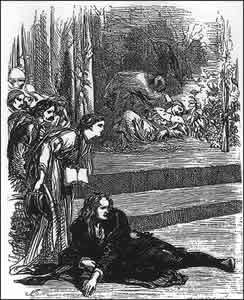![]()
The Charles and Mary Lamb Version
 |
In the almost two centuries since the brother and sister team of Charles and Mary Lamb published Tales from Shakespeare (1807), English speaking children have been introduced to Shakespeare's works (more likely than not) through this book of prose adaptations. Interestingly enough, this publication coincides with a marked shift in the way we perceive Shakespeare's work, and particularly Hamlet as a result of the aesthetic shift in England and western Europe known as "Romanticism." (A further discussion of this shift is included in the section entitled "Does Hamlet Delay?")
What follows here is a section of the retelling of the mousetrap scene from the Charles and Mary Lamb version. It serves as a baseline understanding of the scene which has prevailed for two centuries
| But when Lucianus, according to the story, came to poison Gonzago sleeping
in the garden, the strong resemblance which it bore to his own wicked
act upon the late king, his brother, whom he had poisoned in his garden,
so struck upon the conscience of this usurper, that he was unable to sit
out the rest of the play, but of a sudden calling for lights to his chamber,
and affecting or partly feeling a sudden sickness, he abruptly left the
theater. Now Hamlet had seen enough to be satisfied that the words of
the ghost were true, and no illusion; and in a fit of gaiety, like that
which comes over a man who suddenly has some great doubt or scruple resolved,
he swore to Horatio, that he would take the ghost's word for a thousand
pounds. --Charles and Mary Lamb, Tales from Shakespeare, Dent, London, 1977. p.271. |
The complete text of this prose telling of Hamlet can be found at the following URL: http://shakespeare.palomar.edu/lambtales/LTHAMLET.HTM